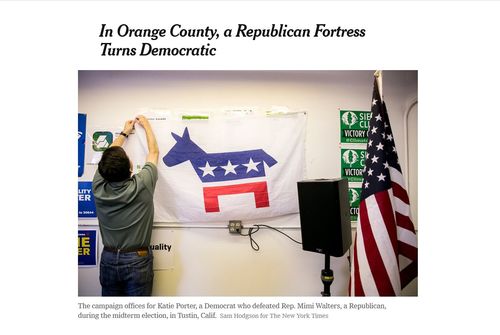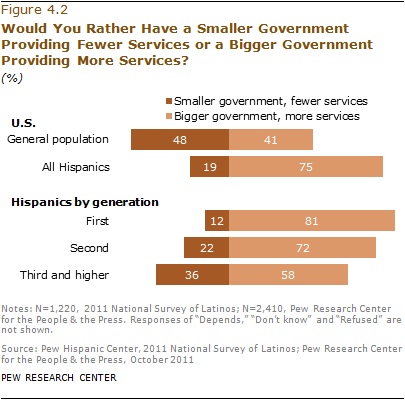
Orange County’s Electoral Gutting By Democrats Is Analyzed
12/31/2018
Monday’s New York Times has a front-page story that illustrates a basic political principle and how it manifests on the local level: big diverse immigration creates more Democrat voters even in formerly conservative bastions, which is why the party supports open borders above all other values.
Orange County used to be a Republican stronghold, even as the state racked up the largest percentage of foreign born in America (27 percent). But the recent election showed that no region is safe from the Democrat diversity onslaught, fueled by excessive immigration.

As noted by Pew pollsters, Hispanic foreigners tend to prefer big government and therefore vote Democrat: they come for America’s economic opportunity provided by free markets but vote to recreate the crapistans they came from. Go figure.
If Republicans in Congress had a brain, they would have voted to reduce legal immigration (in the bill offered by Senators Cotton and Perdue) and worked for restrictionist legislation like E-verify. Instead, Republican leadership pursued their own elite agenda of tax reform and such, about which regular voters have little interest. So many GOP representatives were shown the door in November, particularly in areas which immigration has transformed.
The Times story was reprinted in newsstandhub.com, linked below:
In Orange County, a Republican Fortress Turns Democratic, New York Times, December 31, 2018
WESTMINSTER, Calif. — To appreciate the vast cultural and political upheaval across Orange County over the last 40 years, look no further than Bolsa Avenue. The auto body shop, the tax preparer, a church, a food market, countless restaurants — all are marked by signs written in Vietnamese.
Or head seven miles west to Santa Ana, where Vietnamese makes way for Spanish along Calle Cuatro, a bustling enclave of stores and sidewalk stands serving an overwhelming Latino clientele.
The Democratic capture of four Republican-held congressional seats in Orange County in November — more than half the seven congressional seats Democrats won from Republicans in California — toppled what had long been a fortress of conservative Republicanism. The sweep stunned party leaders, among them Paul D. Ryan, the outgoing House speaker. Even Gavin Newsom, the Democratic governor-elect of California, won the county where Richard M. Nixon was born.
But the results reflected what has been a nearly 40-year rise in the number of immigrants, nonwhite residents and college graduates that has transformed this iconic American suburb into a Democratic outpost, highlighted in a Times analysis of demographic data going back to 1980, the year Ronald Reagan was elected president.
The ideological shift signaled by the most recent election results, on the heels of Hillary Clinton beating Donald J. Trump here in 2016, is viewed by leaders in both parties as a warning sign for national Republicans, as suburban communities like this one loom as central battle grounds in the 2020 elections and beyond.
Those new swing suburban counties were one of the central factors behind the 40-seat Democratic gain in the House in November. Many of them have been changed by an increase in educated and affluent voters who have been pushed toward the Democratic column by some of Mr. Trump’s policies. That partly accounts for what is happening here in Orange County, but the political shifts can also be explained by the rapidly changing cultural, political and economic face of the region and are on display in places like Bolsa Avenue, which is known as Little Saigon.
“There are so many of us here and that is what is contributing to these changes,” said Tracy La, 23, who is Vietnamese. Ms. La helped organize a rally in Westminster in mid-December to protest an attempt by the Trump administration to deport thousands of Vietnam War refugees. It drew hundreds of people to the Asian Garden Mall, one of the largest and oldest Vietnamese-operated malls in the nation.
“This is where the future is heading,” said Mark Baldassare, the president of the Public Policy Institute of California. “I don’t see anything that took place in these elections or the demographic trends that are ongoing, to make me think this is a one-time incident.” (Continues)
